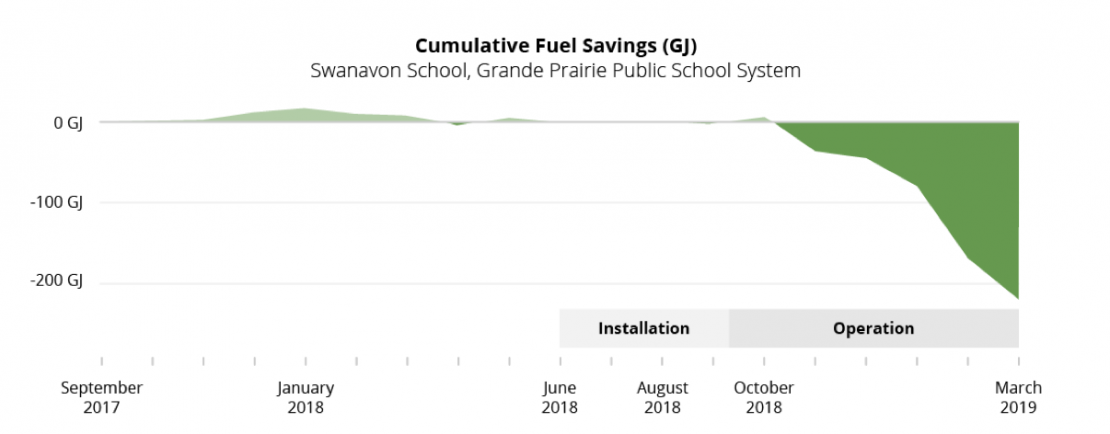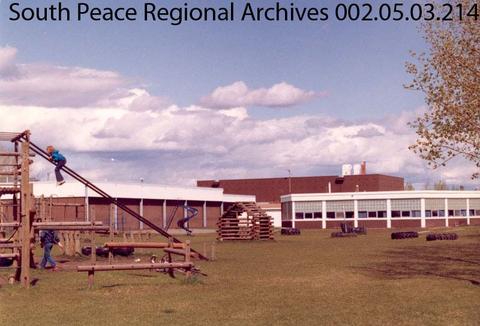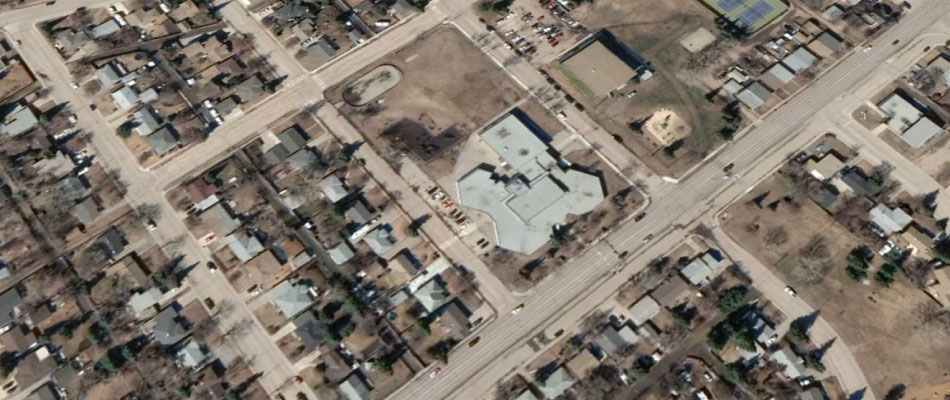Custom boiler system in an Alberta school designed from the ground-up to save energy
Schools are the spot for innovative ideas – even in the boiler room. The maintenance team at a Grande Prairie school applied new ideas to an old problem: how to heat large buildings.
By integrating sensors and controls to continuously monitor and regulate the firing and flow rates, the custom heating plant makes adjustments according to the weather and occupancy of the school.

Swanavon Elementary School in Grande Prairie installed a custom boiler system.
“We pushed the envelope on design,” says Scott Campbell, Mechanical Lead Hand for the Grande Prairie Public School Division. Campbell collaborated with his colleagues in the maintenance department and engineers in Edmonton to design and install the new system from the ground-up.
“We decided to demolish the entire room and sweep the floor and start over. We started from ground zero – brand new everything,” says Campbell, noting that the boilers, circulators, expansion tanks, heat exchanger and control valves were all new.
And the results speak for themselves. The graph below shows the cumulative savings in natural gas since the new boiler system was installed in August 2018. As of March 2019, Swanavon School in Grande Prairie saved over 200 GJ or 15% of natural gas. This fraction will increase as the first half of the heating system was used to optimize the equipment.

Third heating system retrofit for Swanavon School
A complete rebuild of a heating system is not uncommon for old buildings, especially in facilities located in regions with cooler winters. Swanavon School, which was built in 1958, already had one boiler upgrade in 1996.
The latest retrofit at Swanavon School was on the books for the next year, but a series of failures pushed the schedule of the upgrade to 2018.
“I would rather be ahead of the curve and not deal with a failure in the middle of the heating season,” says Campbell, who has been with the division for seven years.
The previous boiler plant was also undersized, limiting its ability to maintain the temperature setpoints in the building on cold days.
It was an opportunity to improve the reliability of the heating plant to make sure students and teachers are comfortable. And for Campbell, it was an opportunity to save the school division money by improving efficiency.
From design to installation
Conception and design began in early 2018. Demolition and installation were scheduled for the summer, when students were away for the summer break and the heating plant could be turned off. Due to cooler-than-expected weather in early June, the demolition was pushed back a few weeks.
Installation was finished when school resumed in the fall – just in time for the return of cool weather. In September 2018, the boiler was operational and final controls and programming were completed in the fall.
Benefits for the entire school community

Swanavon School in 1983
By creating a custom design for the school’s boiler plant, Campbell and the engineers were able to maximize the energy usage specifically for the facility. Any new boiler system would improve comfort and efficiency, but a custom design made it possible to adapt the entire system to the facility to optimize its performance.
The new heating plant has had a noticeable impact on utility bills, and students and teachers can also feel the difference. Or, more importantly, they don’t notice periods of exceedingly hot or cold temperatures.
“The building has more stable comfort,” says Campbell.
For the Grande Prairie School Division maintenance team, the new boiler system is more straightforward to maintain because it uses the same boilers as other schools. Technicians will be able to swap parts and train at one school in order to be an expert in many facilities.
Improvements in reliability benefit both the maintenance staff and school community. Swanavon School now maintains a “stable comfort level and stable temperatures.”
The boiler project was completed at the same time as upgrades to the facility’s lighting. Between October 2018 and March 2019, the lighting upgrades dropped electricity consumption by 25% and the boiler plant reduced fuel consumption by 10%.
Custom design and creative scheduling
The new system at Swanavon School uses two boilers on 100% lead lag, so the second boiler only operates when the heating demand exceeds the capacity of the first boiler. Each boiler injects directly into the main building loop.
As a dynamic system, the firing rates and the circulators for the system and boiler can all be modulated. If the boiler is modulating at 30%, then the boiler and building circulators all run at 30%. All the equipment responds to changes in the boilers’ firing rates. To prevent damage to the copper tubing in the heat exchanger, the flow rates follow the recommendations from the manufacturer.
Every circulator is modulated for flow rate and amperage. Campbell calls the system-wide monitoring the “intel” for his plumbing team, aiding in the optimization of the circulators and combustion blower.
In addition to the mechanical improvements, creative scheduling added an additional bump to overall system efficiency. The radiant panel loop was separated from the air system heat coil loop enabling independent operation and reducing the unnecessary pump energy circulating hot water. Hot water temperatures are adjusted to meet the building demand via the radiators during non-occupied times reducing runtime of the forced air system resulting in run time reduction and wear on the air handlers.
Just as students are encouraged to create innovative solutions for problems, maintenance staff from the Grande Prairie School Division are demonstrating that a critical eye for old school ideas can save energy and money.
